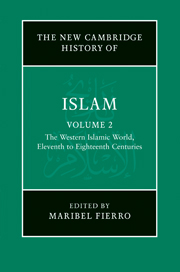Book contents
- Frontmatter
- Introduction
- PART I AL-ANDALUS AND NORTH AND WEST AFRICA (ELEVENTH TO FIFTEENTH CENTURIES)
- PART II EGYPT AND SYRIA (ELEVENTH CENTURY UNTIL THE OTTOMAN CONQUEST)
- 6 Bilād al-Shām, from the Fāṭimid conquest to the fall of the Ayyūbids (359–658/970–1260)
- 7 The Fāṭimid caliphate (358–567/969–1171) and the Ayyūbids in Egypt (567–648/1171–1250)
- 8 The Mamlūks in Egypt and Syria: the Turkish Mamlūk sultanate (648–784/1250–1382) and the Circassian Mamlūk sultanate (784–923/1382–1517)
- 9 Western Arabia and Yemen (fifth/eleventh century to the Ottoman conquest)
- PART III MUSLIM ANATOLIA AND THE OTTOMAN EMPIRE
- PART IV NORTH AND WEST AFRICA (SIXTEENTH TO EIGHTEENTH CENTURIES)
- PART V RULERS, SOLDIERS, PEASANTS, SCHOLARS AND TRADERS
- Glossary
- Bibliography
- Index
- References
7 - The Fāṭimid caliphate (358–567/969–1171) and the Ayyūbids in Egypt (567–648/1171–1250)
from PART II - EGYPT AND SYRIA (ELEVENTH CENTURY UNTIL THE OTTOMAN CONQUEST)
Published online by Cambridge University Press: 28 March 2011
- Frontmatter
- Introduction
- PART I AL-ANDALUS AND NORTH AND WEST AFRICA (ELEVENTH TO FIFTEENTH CENTURIES)
- PART II EGYPT AND SYRIA (ELEVENTH CENTURY UNTIL THE OTTOMAN CONQUEST)
- 6 Bilād al-Shām, from the Fāṭimid conquest to the fall of the Ayyūbids (359–658/970–1260)
- 7 The Fāṭimid caliphate (358–567/969–1171) and the Ayyūbids in Egypt (567–648/1171–1250)
- 8 The Mamlūks in Egypt and Syria: the Turkish Mamlūk sultanate (648–784/1250–1382) and the Circassian Mamlūk sultanate (784–923/1382–1517)
- 9 Western Arabia and Yemen (fifth/eleventh century to the Ottoman conquest)
- PART III MUSLIM ANATOLIA AND THE OTTOMAN EMPIRE
- PART IV NORTH AND WEST AFRICA (SIXTEENTH TO EIGHTEENTH CENTURIES)
- PART V RULERS, SOLDIERS, PEASANTS, SCHOLARS AND TRADERS
- Glossary
- Bibliography
- Index
- References
Summary
Egypt and the historiography of the Fāṭimid–Ayyūbid period
Egypt conquered by the Fāṭimids in 358/969 was rich agricultural land with winter crops (wheat, barley, beans and flax) and summer crops (watermelons, cotton and sugar cane). Egypt’s arable lands were dependent on the Nile whose flow governed the country’s life cycle. The annual rise of the Nile used to begin during June–July and intensified during August. The beginning of the rise made it possible for boats loaded with grain to sail towards the capital and the rising water of the Nile also made the canal of Alexandria navigable. The Nile usually reached its plenitude of 16 cubits as measured at the Cairo’s Nilometer during late August or early September. The new agricultural year began during September or early October when the seeds needed for planting cereals were delivered to the fellahin. Egypt was a wheat-producing country and bread was the staple of its population. However, since the Ṭūlūnid period, flax became Egypt’s main cash crop and its cultivation spread throughout the fourth–seventh/tenth–thirteenth centuries and constituted one of Egypt’s main exports. Flax was not only exported; there was also a strong local demand for it. Egypt had a long tradition of textile manufacture and its production centres such as Tinnīs, Damietta and Bahnasā enjoyed high international reputation.
- Type
- Chapter
- Information
- The New Cambridge History of Islam , pp. 201 - 236Publisher: Cambridge University PressPrint publication year: 2010
References
- 2
- Cited by

